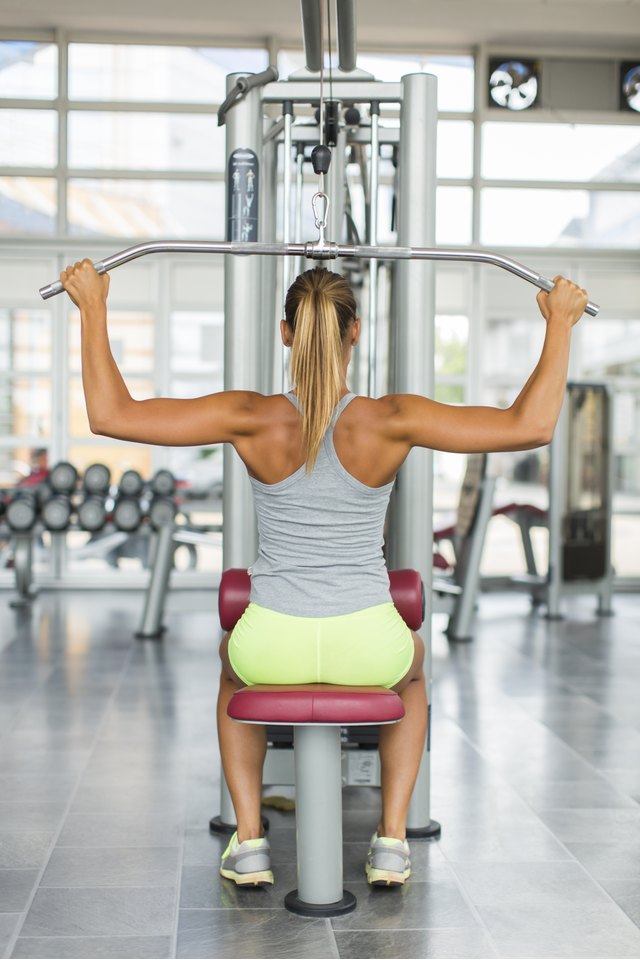Cervical Dystonia Exercises

Cervical dystonia, known as spasmodic torticollis, is a neurological disorder which causes the neck and shoulder muscles to involuntarily contract and spasm, according to the Dystonia Medical Research Foundation. Exercises can improve posture through stretching and strengthening muscles and help reduce pain, according to the MayoClinic.com. No exercise provides a cure-all. Every individual is different, and needs different treatments. Check with your doctor prior to starting any exercise routine.
Head Tilts
Stretching can help your cervical dystonia by loosening your tight muscle fibers. Head tilts can stretch your cervical muscles, according to functionalrestoration.com. Head tilts can be done either with assistance or unassisted. For assisted head tilts, either stand or sit in an upright chair. Stretch your left side neck muscles by placing your right hand onto the left side of your head above your ear. Gently pull your head to the right side with your hand. Hold this stretch for five seconds. Return your head to the original, straight ahead position. Relax for three minutes. Repeat this exercise 10 times. Do the exercise again to your left side. For unassisted head tilts, perform the same exercise without using your opposite-side hand to stretch your neck muscles while moving your head.
Neck and Back Stretch
Stretch your entire spine and neck to help keep your muscles flexible. Stand with your feet shoulder-width apart. Intertwine your fingers and place your hands on the backside of your head. Gently bend your knees as you slowly lower your upper body. Stretch until your head is at knee level. Lower your neck to increase the stretch. Do not pull on your neck. Hold this stretch for 10 seconds. Slowly lift your body up to the original position. Relax for three minutes. Repeat this exercise five times. If you have lower back concerns, do a modified version of this exercise by sitting on a large exercise ball. This will place less stress on your back.
Chair Yoga
Chair yoga exercises can help stretch your shoulders, upper back and neck muscles. Do a Hatha yoga posture known as a Slow Motion Dive. Sit upright in a firm, armless chair. Place your hands on your knees. Slowly inhale to fill your lungs. Slowly lower your upper body to your lap and knees while exhaling. Allow your head to hang and relax between your legs. Bend as far as possible. If you are comfortable, increase your stretch by lowering your hands to the floor. Hold your stretching position for one minute. Breathe fully as you stretch. Inhale as you lift yourself with your arms back to the original position. Relax for three minutes. Repeat this exercise 10 times.
Downward Facing Dog
Do a yoga posture known as Downward Facing Dog to strengthen your shoulders and relax your neck muscles. This posture also helps increase your leg flexibility. Stand upright with your feet shoulder-width apart. Slowly lean your upper body forward. Instead of touching your toes, walk your hands out two to three feet from your body. Place your palms flat on the floor. Let your neck hang. Keep your elbows and knees straight. Hold this position for 10 to 20 seconds. Slowly walk your hands back to your feet and return your upper body to the original position. Relax for two minutes. Repeat this exercise three times.
References
- Lurati AR. Health issues and injury risks associated with prolonged sitting and sedentary lifestyles. Workplace Health Saf. 2018;66(6):285-290. doi:10.1177/2165079917737558
- Nakphet N, Chaikumarn M, Janwantanakul P. Effect of different types of rest-break interventions on neck and shoulder muscle activity, perceived discomfort and productivity in symptomatic VDU operators: A randomized controlled trial. Int J Occup Saf Ergon. 2014;20(2):339-53. doi:10.1080/10803548.2014.11077048
- Cooley D, Pedersen S. A pilot study of increasing nonpurposeful movement breaks at work as a means of reducing prolonged sitting. J Environ Public Health. 2013;2013:128376. doi:10.1155/2013/128376
- Daneshmandi H, Choobineh A, Ghaem H, Karimi M. Adverse effects of prolonged sitting behavior on the general health of office workers. J Lifestyle Med. 2017;7(2):69-75. doi:10.15280/jlm.2017.7.2.69
- Henning RA, Jacques P, Kissel GV, Sullivan AB, Alteras-Webb SM. Frequent short rest breaks from computer work: Effects on productivity and well-being at two field sites. Ergonomics. 1997;40(1):78-91. doi:10.1080/001401397188396
- Ylinen J, Kautiainen H, Wirén K, Häkkinen A. Stretching exercises vs manual therapy in treatment of chronic neck pain: A randomized, controlled cross-over trial. J Rehabil Med. 2007;39(2):126-32. doi:10.2340/16501977-0015
Writer Bio
Crystal Welch has a 30-year writing history. Her more than 2,000 published works have been included in the health and fitness-related Wellness Directory, Earthdance Press and Higher Source. She is an award-winning writer who teaches whole foods cooking and has written a cookbook series. She operates an HON-code-certified health-related blog with more than 95,000 readers. Welch has a B.B.A. from Eastern Michigan University.
